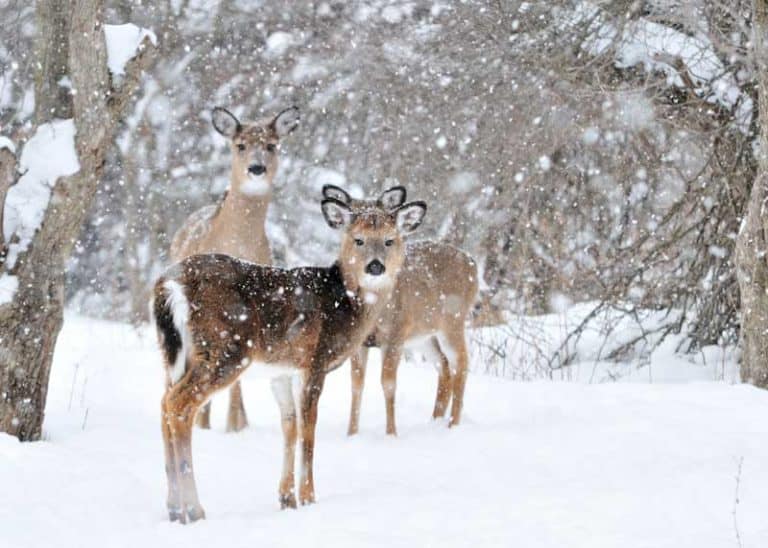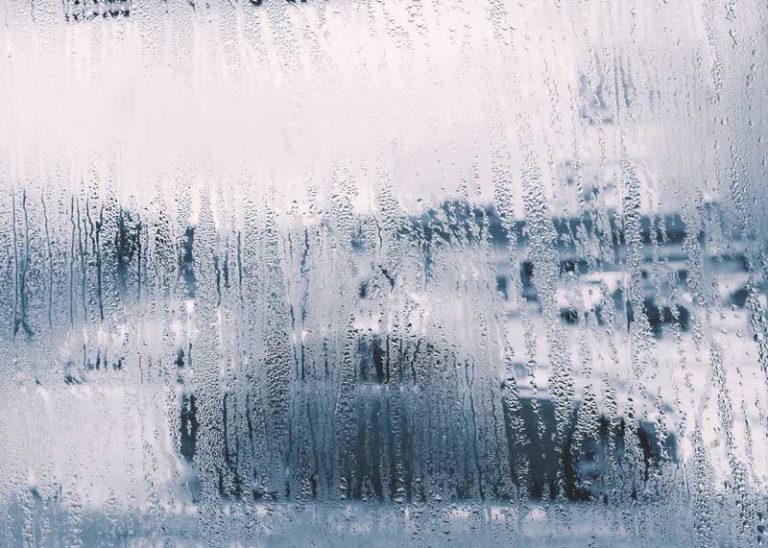What Do Deer Eat in the Winter? Feeding Rules in USA, Canada
White-tailed deer fatten up as it begins to get colder outside. This helps them throughout the colder months when food is scarce. What do deer eat in the winter? Here are the rules for feeding deer in the USA and Canada.
Deer eat woody browse in the winter. This can be leaves, berries, saplings, bulbs, or buds. In wintertime, they will take their pickings from the ground. They can also have some lush forage such as kale, radish, turnips, apples, or sugar beets if it is available.

Deer can usually forage for their food, but some states and provinces permit people to feed deer in their area.
It’s important to know the laws so you don’t disrupt the deer’s usual eating habits. We’ll cover more information about this below!
What Deer Like to Eat
Deer will eat hundreds of different species of plants. They love fruits and some vegetables. They’ll munch on most greenery as well.
Corn is a deer’s favorite treat.
Some other favorite foods include blackberries, greenbriers, saplings, honeysuckle, hackberry, grapevines, acorns, apples, pears, kale, radish, turnip, canola, cabbage, cauliflower, and sugar beets.
They also enjoy eating the leaves from elm, birch, white pine, white cedar, and maple trees.
Most flower bulbs, roots, vines, and saplings are also great deer food.
New Foods for Deer
When it comes to feeding deer at any point in the year, you need to take into consideration their bodies’ current state.
Depending on the season, the deer will search for specific foods for their bodies that help them prepare for the future or what is available.
Deer’s bodies will also be more adapted to digesting certain foods in certain seasons. During the fall, deer are more inclined to eat corn and acorns. They’re a great clean-up crew after you harvested all your corn.
With this in mind, feed deer the plants that typically grow around this time of year. Here are some examples for each season.
- Fall: Corn, acorns, hackberry, apples, kale, radish, and turnips.
- Winter: Grapevines and leaves.
- Spring: Greenbriers, honeysuckles, grapevines, pears, and radish.
- Summer: Blackberries, hackberry, and pears.
Deer can eat corn in the spring and pears in the winter.
However, you need to be extra careful. Don’t just leave out a bucket of pears for the deer. Do a little bit at a time. Spread a little bit of the new food around where they normally eat.
This will help their bodies slowly adjust to the change in food.
If you regularly feed deer, do this for two to three weeks and then they’ll be adjusted to the new food. If this is a one-time thing, just don’t feed them too much.
Here’s how deer stay warm in the winter.
Rumen Acidosis
Rumen acidosis is a deer disease they can get in the winter if they are fed incorrectly. During the wintertime, their bodies mostly rely on the fat they gain in the fall for energy.
Rumen acidosis is caused by an excess of carbohydrates, especially grain, according to the Pennsylvania Game Commission.
They still eat a good amount, but it is minimal and will take a while to digest. The foods they eat in the winter, such as leaves, provide them with the nutrients they need to survive. However, if they eat the wrong foods in the winter or too much of anything, it can mess with their health and they could die.
Problems with Feeding Deer
First off, feeding a deer consistently isn’t recommended. There are some people who feed deer on a regular basis for hunting purposes.
Of course, there are regulations and guidelines for doing so. Over time, the deer can become used to the process and maintain a healthy lifestyle.
You should not leave food out in hopes that deer will flock to your yard. You should also avoid trying to feed a deer regularly as a pet if you haven’t done extensive research and talked with an expert. They can spread parasites and diseases if you’re not careful.
Rumen acidosis is most commonly caused when deer will eat too much corn in the winter. Corn doesn’t have as much fiber in it and has more carbohydrates.
In the winter, the deer’s digestive system is slow and will absorb more necessary nutrients. Eating corn can mess with their digestive system and make it hard to absorb other foods. This will then dehydrate the deer and kill it.
Leave it to the deer to provide for themselves. They have the biology to survive and probably have done so for many winters before.
I know you may want to hold out a little bit of food in hopes they’ll nibble a bit from your hand, but you shouldn’t do that. It is best to let them live their lives and we live ours to keep them safe and healthy.
Supplemental Diet Can Help Deer During Winter
Choosing to feed deer early in the season, introducing foods incrementally, and maintaining the program until spring are all good ways to keep them healthy during winter.
Avoid changing the foods quickly to avoid health problems like rumen acidosis. Source: Bangor Daily News

Is it Legal to Feeding Deer in My State?
Each state has different laws and regulations when it comes to feeding deer. This is mostly for people who hunt because they like to keep herds of deer year-round or bait many to one area with a constant supply of food.
Even if you don’t hunt, these rules are good to know for the sake of the beautiful deer living near you or if you’re thinking about opening a good zoo or sanctuary for deer.
Most states focus on three main things: feed, baiting, and feed placement. I am not going to go through every state because they are all different, but I can give you some general information.
- First, you should check to see if you can even feed the deer in your area and the restrictions surrounding that. Some places will let you feed and keep deer on your property or nearby and others won’t.
- Secondly, you need to see if you can use the feed for baiting deer closer or for hunting purposes.
States could allow you to bait deer closer but then they can also say you can’t do it during certain seasons.
That is the final thing you should check, when can you feed the deer in certain areas and when can’t you when it comes to baiting.
There are various other little details and regulations depending on the state you live in. Be sure to read up on everything.
Here’s a summarized list of the regulations for each state.
Feeding Deer in Canada: All Regions
Here’s where it’s legal and illegal to feed deer in Canada. This list covers all 10 provinces and 3 territories.
- Nova Scotia: Allowed. Here’s what the Nova Scotia Department of Lands and Forestry says.
- New Brunswick: Discouraged. In their document “Do Not Feed Wildlife” they, not surprisingly, ask people to not feed deer. A 2019 by-law in the city of Saint John makes it illegal to feed deer.
- Prince Edward Island: There are no deer (or moose) on PEI.
- Newfoundland and Labrador: There are no deer on the island of Newfoundland or on mainland Labrador. This might be surprising, given the presence of Deer Lake (lake, community, and airport). Apparently, European settlers called the Woodland Caribou “deer”.
- Quebec: Discouraged. Here is their press release.
- Ontario: Allowed. Here are the guidelines from Ontario Ministry of Natural Resources.
- Manitoba: Discouraged. In their document, “Don’t Feed the Deer”, they outline reasons not to feed them.
- Saskatchewan: Discouraged. They state that “Best intentions may cause more harm than good.”
- Alberta: Strongly discouraged. They state “Never Feed Deer”. And it is illegal to bait deer for hunting.
- British Columbia: Discouraged. This document outlines the reasons why deer (and other ungulates) shouldn’t be fed by humans.
- North West Territories: Illegal. It is illegal to intentionally feed wildlife in the NWT.
- Yukon: Illegal. It is illegal to feed wildlife in Yukon Territory.
- Nunavut: Illegal. The territory’s wildlife act makes it illegal to feed wild animals.
It is important to note that these rules can change. And while specific regions might allow it, smaller municipalities within that province or territory might prohibit it.
Where I live in Nova Scotia, Canada there is no need to feed them. They are visible year-round and we commonly have them come into our backyard to eat apples that have fallen from the trees. They’ll even dig them up through the snow.

You might see deer while hiking this winter. Here are 35 tips for winter hiking.
Film Your Backyard Wildlife
If you choose to feed deer in your area, you should consider setting up a wildlife camera. This is one by Bushnell and is a reader favorite.
Here’s how to hide your trail camera from humans. And how to connect a trail camera to a computer.
Your Turn
Have you seen deer feeding in your area? Have a question for me? Join me in the comments!







We live in rural MINN. I have been feeding a deer herd oats (6 to 15 per night) for about 4 weeks. I am putting out about 6 to 7 #’s per evening (50#’s per week) in 6 small buckets. Should I just spread out the oats, rather than place in buckets?